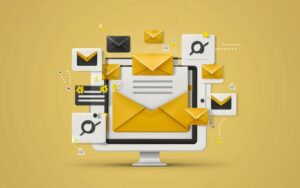We’ve all been there — you hit send on an important email and then — oops, you realize you spelled the recipient’s name wrong. Or used the wrong form of “their.” Or forgot to include a critical attachment.
We all make mistakes. Even when you’re working in your email, where you have the ability to pause and edit, mistakes happen — and you want to avoid that.
Here, we’ve compiled a list of the best email tips to help you avoid common mistakes and make your emails more attention-grabbing.
1. Personalize your email
Personalizing your email is a great way to get a prospect’s attention. It shows that you’ve done your research and that you’re not just sending out a generic email to everyone on your list.
There are a few different ways you can personalize your emails. You can use the recipient’s name in the subject line or intro, or you can reference something specific to them or their business. For example, you could mention a recent blog post they wrote or a product they sell.
2. Be upfront about your purpose for emailing
Sometimes, you don’t need to beat around the bush. If you have a clear reason for emailing someone, don’t be afraid to state that reason in the beginning of your email.
In fact, it’s often best to be direct about your purpose for emailing, especially if you’re reaching out to a prospect or someone who’s not expecting to hear from you. This can help you grab your recipient’s attention and earn their trust.
If you’re emailing a prospect, you might want to start by mentioning a recent interaction you had, like meeting them at a conference, or a mutual connection you share. This can help you establish rapport and set the stage for your ask.
In the example below, the salesperson mentions a recent meeting to establish context before asking their prospect to connect them with a colleague.
If you’re emailing someone you haven’t met, you might want to start by briefly introducing yourself and your company, and then explain why you’re reaching out. If you have a mutual connection, you could also mention that to build trust.
Check out the example below to see how a salesperson introduces themselves and their company before stating their purpose for reaching out.
3. Make the recipient feel special
People love to feel special, and if you can make your recipient feel that way with your email intro, you’re off to a great start.
You can do this by using the recipient’s name in your intro, or by mentioning something specific about them or their business. If you’ve done your research and you know a little bit about the person you’re emailing, use that information to your advantage.
For example, you could mention a recent blog post they wrote, or a project they worked on. This shows that you’ve taken the time to get to know them, and that you’re not just sending a generic email.
4. Use a casual tone
It’s important to use the right tone when writing your email introductions. Your tone should be appropriate for your audience and the topic you’re discussing. If it is hard for you, make sure to have a white label copywriter help you with the tone.
For example, if you’re emailing a new prospect, you might want to use a more formal tone. If you’re emailing a colleague, you might want to use a more casual tone.
In general, it’s best to use a casual tone in your email introductions. This will help you come across as friendly and approachable, and it will make your email more pleasant to read.
Using a casual tone doesn’t mean you should be unprofessional. You should still be respectful and polite in your email introductions. But you can use a more conversational tone to help you connect with your reader.
5. Mention a mutual connection
When you have a mutual connection with your email recipient, use it to your advantage. This is an easy way to build trust with your recipient right from the start. When someone sees that you know someone they trust, they’ll be more likely to trust you, too.
If you have a mutual connection, make sure to mention that person in your email intro. You can say something like, “I was talking to [mutual connection’s name] the other day and they mentioned that I should reach out to you.”
This will help you build a relationship with your recipient and make them more likely to read the rest of your email.
6. Get straight to the point
If you have a clear reason for reaching out, don’t hide it in a long-winded introduction. Get straight to the point and let your recipient know why you’re emailing them.
This is especially important if you’re asking for something, like a favor or a reply. If you bury your ask in the middle of a long email, your recipient might miss it.
Instead, put your reason for reaching out in the first sentence of your email. That way, even if your recipient doesn’t read the entire message, they’ll still know what you need from them.
7. Tell a story
Storytelling is a great way to hook your audience in any type of content, and email is no different. The key to storytelling in your email intro is to keep it short and relevant to your overall message.
In the example below, the email intro tells a quick story about the sender’s kids and how they’ve been handling the COVID-19 pandemic. Then, the email goes on to discuss how the company is handling the pandemic and what they’re doing to support their customers.
By starting with a personal story, the sender is able to build a connection with the reader before diving into the business-related content. This technique can be especially effective for B2B companies that want to show off their human side.
8. Ask a question
People are hardwired to answer questions. It’s a natural instinct, and you can use it to your advantage in your email intros.
When you ask a question, you create an open loop in the reader’s mind. They want to know the answer, so they keep reading.
You can ask a question that relates to the rest of your email, or you can ask a question that’s designed to get a “yes” response from your reader. This is a powerful way to get people to engage with your email and build a sense of rapport.
For example, you could ask something like, “Are you tired of spending hours on your marketing every week?” If your reader answers “yes,” they’re much more likely to keep reading.
Just be sure to ask questions that are relevant to your audience and that you can answer in the body of your email.
9. Offer something of value
People love getting free stuff. So, if you can, offer a free resource in your email intro. This can be a free guide, ebook, template, or even a demo of your product.
The key here is to make sure your free resource is directly related to the topic of your email. Otherwise, your readers may not be interested.
For example, let’s say you’re a marketing consultant and you’re writing an email about the importance of social media for businesses. You could offer a free social media audit template in your email intro or suggest a social media tool to manage all accounts from a single dashboard. This would be a great way to provide value to your readers and encourage them to keep reading.
In addition to free resources, you can also offer discounts, early access to new products, or even just helpful tips and advice in your email intro.
10. Create a sense of urgency
Creating a sense of urgency in your email intro is a great way to get your readers to act fast.
You can do this by letting your readers know that they need to act quickly in order to take advantage of a special offer or discount, or by telling them that the information you’re about to share with them is time-sensitive.
You can also create a sense of urgency by letting your readers know that they need to act quickly in order to avoid a negative outcome. For example, you could let your readers know that they need to act quickly in order to avoid missing out on a limited-time opportunity, or you could let them know that they need to act quickly in order to avoid a price increase.
11. Use a shocking statistic
People are more likely to open an email when they feel like they’re going to learn something new. And one of the best ways to do that is by sharing a shocking statistic in your email intro.
For example, if you’re a financial advisor, you might start an email with a statistic about how many people are unprepared for retirement. Another example would be to browse through the current content marketing statistics and highlight an important one in the subject line of a marketing campaign to pique reader interest. This can be a great way to grab your readers’ attention and make them feel like they need to keep reading to learn more.
12. Be mysterious
If you don’t want to give away the plot of your email in the introduction, don’t. Instead, you can create a sense of mystery by hinting at the main topic or offering a small teaser.
In the example above, the email writer creates a sense of mystery by asking a question that the rest of the email will answer. This is a great way to pique the curiosity of your readers and get them to keep reading.
Conclusion
Emails are a powerful tool for communicating with your prospects and customers. But to get the most out of them, you need to ensure your emails are opened. And to get your emails opened, you need to create attention-grabbing email intros.
Remember, you only have a few seconds to make a strong first impression with your email intro. So, use the tips and techniques we reviewed in this article to captivate your readers and make them want to read your email from start to finish.




